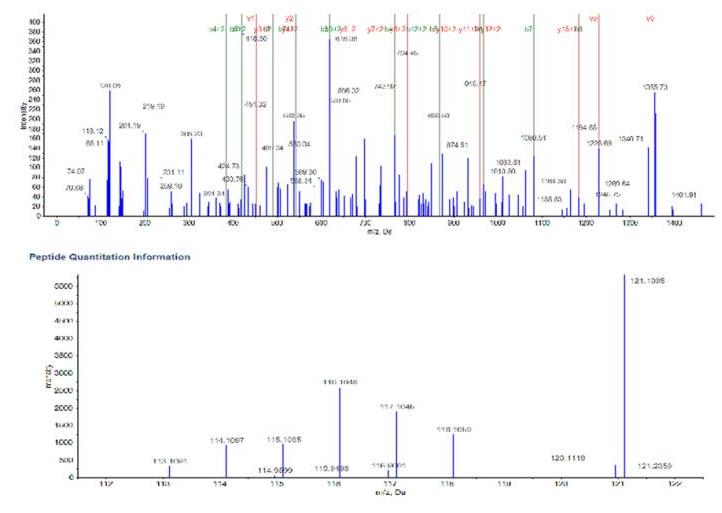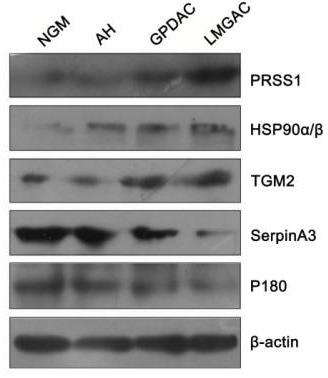PRSS1
-
Official Full Name
protease, serine, 1 (trypsin 1) -
Overview
This gene encodes a trypsinogen, which is a member of the trypsin family of serine proteases. This enzyme is secreted by the pancreas and cleaved to its active form in the small intestine. It is active on peptide linkages involving the carboxyl group of lysine or arginine. Mutations in this gene are associated with hereditary pancreatitis. This gene and several other trypsinogen genes are localized to the T cell receptor beta locus on chromosome 7. -
Synonyms
PRSS1;protease, serine, 1 (trypsin 1);TRY1;trypsin-1;Alpha-trypsin chain 2;Beta-trypsin;Cationic trypsinogen;Serine protease 1;TRY1_HUMAN;Trypsin I;trypsinogen 1;trypsinogen A;digestive zymogen;nonfunctional trypsin 1;TRP1;TRY4;TRYP1
Recombinant Proteins
- Human
- Rat
- Rhesus macaque
- Mouse
- Mammalian cells
- Human Pancreas
- E.coli
- E.Coli or Yeast
- Mammalian Cell
- HEK293
- Yeast
- His
- Non
- His&Fc
- N-His-GST
- His&Myc
- His&Fc&Avi
- His&SUMO
Background
What is PRSS1 Protein?
The PRSS1 gene is key for producing an enzyme called cationic trypsinogen, crucial for digestion. Made in the pancreas, this enzyme helps break down proteins in the small intestine. It first turns into trypsinogen, then into active trypsin, a digestive workhorse. If the PRSS1 gene has mutations, it can lead to hereditary pancreatitis, causing the enzyme to activate too early or resist being broken down. This misfiring can inflame the pancreas, resulting in painful episodes. These glitches often replace certain amino acids in the enzyme's structure, leading to digestive trouble.What is the Function of PRSS1 Protein?
The PRSS1 protein, known as cationic trypsinogen, plays a central role in digestion. This enzyme starts out in the pancreas and becomes activated in the small intestine, where it turns into trypsin. In its active form, trypsin chops protein chains into smaller pieces, which helps in breaking down food so the body can absorb nutrients. Besides digestion, trypsin also switches on other digestive enzymes, making the whole process smooth and efficient. If something goes wrong, such as with certain gene mutations, it can lead to unwanted enzyme activation, which might cause issues like pancreatitis.PRSS1 Related Signaling Pathway
The PRSS1 protein, or cationic trypsinogen, is linked to certain signaling pathways in the body, particularly those involving digestion. Once activated, trypsin can influence pathways that facilitate protein breakdown, aiding nutrient absorption in the small intestine. Apart from its digestive duties, trypsin might also partake in signaling pathways related to inflammation and cellular responses, especially when things go awry, such as in conditions like pancreatitis. This misstep can trigger pathways causing pancreatic inflammation and damage, showing how vital controlled activation of PRSS1 is in maintaining digestive and cellular balance.PRSS1 Related Diseases
The PRSS1 gene is closely tied to hereditary pancreatitis. This condition usually arises due to mutations in the PRSS1 gene, where these changes lead to early or excessive activation of trypsin, causing pancreatic inflammation. One common mutation is the R122H change, which hinders the normal breakdown of trypsin, letting it accumulate and damage the pancreas. This gene is essential for making trypsinogen, and mutations in PRSS1 are a significant factor in hereditary pancreatitis due to their impact on how digestive enzymes behave, ultimately disrupting normal pancreatic function.
Fig1. Relative risk and incidence of risk factors for pancreatic cancer. (Kodai Abe, 2021)
Bioapplications of PRSS1
The PRSS1 gene is mostly known for its role in digestion due to its encoding of cationic trypsinogen, an enzyme that's crucial for breaking down proteins. However, beyond digestion, PRSS1 has potential bioapplications in understanding and managing pancreatic disorders, especially hereditary pancreatitis. Mutations in this gene can lead to early activation of trypsin, causing pancreatic inflammation. By studying PRSS1, researchers are looking into therapies that could inhibit or modify the enzyme's activity, preventing or treating pancreatitis. Its relevance extends to genetic research for predicting pancreatitis risk and developing personalized medicine approaches for managing pancreatic diseases.Case Study
Case Study 1: Peng C. et al. Nat Commun. 2024
Researchers found that antimicrobial peptides (AMPs) don't ramp up well in macrophages against Mycobacterium tuberculosis due to an unknown mechanism. They've discovered L-alanine binds with PRSS1 to open up the NF-κB pathway, boosting AMPs. However, Mycobacterium uses its alanine dehydrogenase, Rv2780, to cut L-alanine levels, lowering AMP expression and aiding bacteria survival. L-alanine counters PRSS1's inhibition of the TAK1/TAB1 complex, activating the NF-κB pathway to promote AMPs. Deleting β-defensin 4 weakens Rv2780 during mouse infections. Both L-alanine and the Rv2780 inhibitor, GWP-042, show strong effects against M. tuberculosis in live models, revealing a new immune evasion strategy and potential treatment targets.-
 Fig1. Streptavidin pulldown assays of the binding of biotin-conjugated L-alanine to recombinant PRSS1.
Fig1. Streptavidin pulldown assays of the binding of biotin-conjugated L-alanine to recombinant PRSS1. -
 Fig2. MicroScale Thermophoresis (MST) assay of the direct interaction of L-alanine with Prss1.
Fig2. MicroScale Thermophoresis (MST) assay of the direct interaction of L-alanine with Prss1.
Case Study 2: Ye D. et al. Int J Biol Sci. 2021
Researchers looked into gastric carcinoma (GC), a serious cancer threat. They used laser capture microdissection and proteomics to track 243 proteins, focusing on serine protease 1 (PRSS1). Through immunohistochemistry and Western blot, they checked PRSS1's role in GC cell growth using MTT and colony formation tests. They also studied miR-146a-5p's expression using qRT-PCR, discovering it targets PRSS1, as confirmed by a dual luciferase test. Boosting PRSS1 speeds up cell growth and spread, while blocking it slows down MGC803 cells by reducing ERK pathway activation. MiR-146a-5p cuts down on PRSS1, hindering these cancer cells' growth.-
 Fig3. MS/MS maps for identifying peptides of PRSS1 and relative quantitative information of PRSS1 expression in four different tissues.
Fig3. MS/MS maps for identifying peptides of PRSS1 and relative quantitative information of PRSS1 expression in four different tissues. -
 Fig4. Western blotting was performed to detect the expression of PRSS1, HSP90α/β, TGM2, SerpinA3 and P180.
Fig4. Western blotting was performed to detect the expression of PRSS1, HSP90α/β, TGM2, SerpinA3 and P180.
Quality Guarantee
High Purity
-
.jpg) Fig1. SDS-PAGE (PRSS1-273H)
Fig1. SDS-PAGE (PRSS1-273H) -
.jpg) Fig2. SDS-PAGE (PRSS1-6015H)
Fig2. SDS-PAGE (PRSS1-6015H)
Involved Pathway
PRSS1 involved in several pathways and played different roles in them. We selected most pathways PRSS1 participated on our site, such as Neuroactive ligand-receptor interaction,Pancreatic secretion,Protein digestion and absorption, which may be useful for your reference. Also, other proteins which involved in the same pathway with PRSS1 were listed below. Creative BioMart supplied nearly all the proteins listed, you can search them on our site.
| Pathway Name | Pathway Related Protein |
|---|---|
| Pancreatic secretion | CTRB1,CA2,PLA2G5,CLCA4,CELA2B,AMY2B,Cel,CELA3B,CCKAR,PNLIPRP1 |
| Protein digestion and absorption | COL21A1,MEP1B,ATP1B3,CPB1,CTRL,COL15A1,ATP1A4,SLC9A3,ATP1B1,COL6A5 |
| Influenza A | HSPA1B,MAP2K1,IFNA3,IL-8,AKT2,RAF1,AKT1,RELA,NLRP3,GSK3B |
| Neuroactive ligand-receptor interaction | CHRNA2A,MC1R,TAAR9,HTR1B,CCKBR,CHRNA4,CNR2,TAAR1,SCTR,CHRM2A |
-
 Fig1. Pathway and genes involved in premature activation of proteases. (Erum Khan, 2023)
Fig1. Pathway and genes involved in premature activation of proteases. (Erum Khan, 2023) -
 Fig2. Trypsin-dependent pathological pathway in chronic pancreatitis. (Eszter Hegyi, 2017)
Fig2. Trypsin-dependent pathological pathway in chronic pancreatitis. (Eszter Hegyi, 2017)
Protein Function
PRSS1 has several biochemical functions, for example, metal ion binding,serine-type endopeptidase activity. Some of the functions are cooperated with other proteins, some of the functions could acted by PRSS1 itself. We selected most functions PRSS1 had, and list some proteins which have the same functions with PRSS1. You can find most of the proteins on our site.
| Function | Related Protein |
|---|---|
| serine-type endopeptidase activity | PCSK5,PRSS21,HTRA1A,TPP2,HGF,KEX2,PRSS2,HTRA4,TMPRSS11F,F7I |
| metal ion binding | PLCH2,SNAI1A,NUDT8,ZNF563,ARAP2,PHF23A,ACLY,MYLK,IRF2BP1,RBM26 |
Interacting Protein
PRSS1 has direct interactions with proteins and molecules. Those interactions were detected by several methods such as yeast two hybrid, co-IP, pull-down and so on. We selected proteins and molecules interacted with PRSS1 here. Most of them are supplied by our site. Hope this information will be useful for your research of PRSS1.
GRB2;ALB;PPP2R2B;STK38L
Resources
Related Services
Related Products
References


